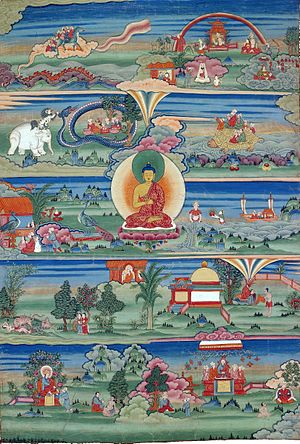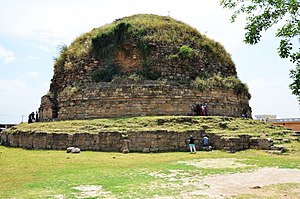Jataka tales
| Early Buddhist Texts |
|---|
| Sutra Pitaka |
| Other collections |
| See also: Early Buddhism, Buddhist canons |

The Jātaka tales are stories of the past lives of Gautama Buddha. In a typical story, the Buddha will recount one of his past lives as a human or animal, demonstating a particular virtue in the process.
Within the Buddhist Canons
Each of the three major Buddhist Canons contain their own versions of the Jataka tales. See:
Style of literature
The Buddhist traditions identify nine or twelve categories of literature. The Jataka tales belong to:
- one of the Nine categories of teachings of the Pali tradition
- one of the Twelve categories of teachings of the Sanskrit tradition
History
According to A. K. Warder, the Jātakas were originally amongst the earliest Buddhist literature, with metrical analysis methods dating their average contents to around the 4th century BCE.[1] According to Warder, the Jātakas are the precursors to the various legendary biographies of the Buddha, which were composed at later dates.[2] Although many Jātakas were written from an early period, which describe previous lives of the Buddha, very little biographical material about Gautama's own life has been recorded.[2]
The Mahāsāṃghika Caitika sects from the Āndhra region took the Jātakas as canonical literature and are known to have rejected some of the Theravāda Jātakas which dated past the time of King Ashoka.[3] The Caitikas claimed that their own Jātakas represented the original collection before the Buddhist tradition split into various lineages.[1]
Jātaka stupas

Many stupas in northern India are said to mark locations from the Jātaka tales; the Chinese pilgrim Xuanzang reported several of these. A stupa in Pushkalavati, in northwestern Pakistan, marks where Syama fulfilled his filial duty to his blind parents. The Mankiala stupa near Gujar Khan commemorates the spot where Prince Sattva sacrificed himself to feed baby tigers.[4] Nearby the ascetic Ekasrnga was seduced by a beautiful woman. In Mangalura, Ksantivadin submitted to mutilation by a king. At Hadda Mountain a young Brahmin sacrificed himself to learn a half verse of the dharma. At Sarvadattaan an incarnation sold himself for ransom to make offerings to a Brahmin.[5]
Faxian describes the four great stupas as being adorned with precious substances. At one site king Sibi sacrifices his flesh to ransom a dove from a hawk. Another incarnation gave up his eyes when asked; a third incarnation sacrificed his body to feed a hungry tigress. As King Candraprabha he cut off his head as a gift to a Brahmin.[6] Some would sever their body parts in front of stupas that contained relics; or even end their own lives.
See also
References
- ↑ 1.0 1.1 Warder, A.K. Indian Buddhism. 2000. pp. 286-287
- ↑ 2.0 2.1 Warder, A.K. Indian Buddhism. 2000. pp. 332-333
- ↑ Sujato, Bhikkhu. Sects & Sectarianism: The Origins of Buddhist Schools. 2006. p. 51
- ↑ 4.0 4.1 Bernstein, Richard (2001). Ultimate Journey: Retracing the Path of an Ancient Buddhist Monk who Crossed Asia in Search of Enlightenment. A.A. Knopf. ISBN 9780375400094. Retrieved 16 June 2017.
- ↑ John Strong 2004, p. 52
- ↑ John Strong 2004, p. 53
Sources
- John Strong (2004). Relics of the Buddha. Princeton University Press. ISBN 0-691-11764-0.
Further reading
- Cowell, E.B.; ed. (1895). "The Jataka or Stories of the Buddhaś former Births, Vol.1-6, Cambridge at the University Press. Vol. 1, vol. 2, vol. 3, vol. 6
- Francis, Henry Thomas (1916). Jātaka tales, Cambridge: University Press
- Grey, Leslie (1990). Concordance of Buddhist Birth Stories, Oxford : Pali Text Society. (Tabulates correspondences between various jataka collections)
- Horner, Isaline Blew; Jaini, Padmanabh S. (1985). Apocryphal Birth-stories (Paññāsa-Jātaka), London ; Boston: Pali Text Society, distributed by Routledge & Kegan Paul. ISBN 9780860132332
- Jacobs, Joseph (1888), The earliest English version of the Fables of Bidpai, London Google Books (edited and induced from The Morall Philosophie of Doni by Sir Thomas North, 1570)
- Khan, Noor Inayat (1985). Twenty Jataka Tales, Inner Traditions
- Rhys Davids, T.W. (1878). Buddhist birth-stories: Jataka tales. The commentarial introd. entitled Nidanakatha; the story of the lineage. Translated from V. Fausböll's ed. of the Pali text, London: G. Routledge
- Martin, Rafe (1998) "The Hungry Tigress: Buddhist Myths, Legends and Jataka Tales". ISBN 0938756524
- Shaw, Sandra (2006). The Jatakas — Birth Stories of the Bodhisatta, New Delhi: Penguin Books
- Skilling, Peter (2006). Jataka and Pannasa-jataka in South-East Asia, Journal of the Pali Text Society 28, 113-174
External links
- Jataka - volume I, vol. II, vol. III, vol. IV, vol. V, vol. VI of E. B. Cowell 1895
- Jataka Tales - by Ellen C. Babbitt 1912
- Buddhist Birth Stories (Jataka Tales), T. W. Rhys Davids, London 1880, archive.org
- Jataka Tales - English Animation
- "The Illustrated Jataka & Other Stories of the Buddha" by Dr C. B. Varma - Illustrated, English[dead link]
- Jataka: from Pali Proper Names
- Buddhist tales
- jataka katha
- jathakakatha.lk
- Learning From Borobudur documentary about the stories of Jatakas, Lalitavistara and Gandavyuha from bas-reliefs of Borobudur, YouTube
| This article includes content from Jataka tales on Wikipedia (view authors). License under CC BY-SA 3.0. |